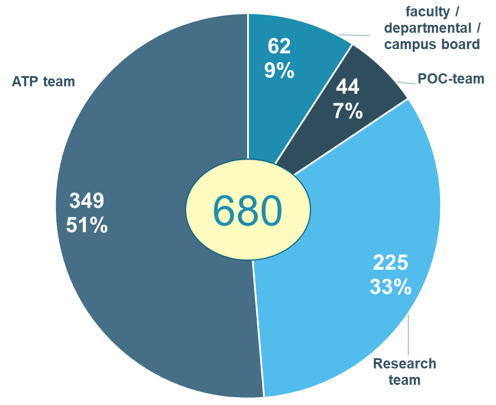Research design
For the purpose of this study, an online survey was designed and implemented using the Qualtrics platform. Participants could indicate here how they perceived different leadership behaviours and roles within their own team, as well as various team and personal constructs. The specific leadership roles and behaviours used in the survey can be found here.
To ensure a comprehensive sample, the link to participate in the study was distributed through email to all of the university's employees and the survey could be accessed both in Dutch and in English. This approach facilitated access to a diverse range of participants with varying backgrounds and roles within the organisation. Important to note is that people could only fill out the survey as a team member, and not as a formal leader, in order to recruit an adequate sample in board teams as well.
Participants
Following the data cleaning process, the total of participants included in the analysis amounted to 918 individuals. This section will discuss various demographics relating to the participants.
The following pie chart presents the distribution of our participants across different age groups. Approximately half of our participants belong to the age range of 20 to 40 years, while the remaining half falls within the age range of 41 to 70+ years.

The next pie chart illustrates the gender distribution within our participant sample. The majority of participants identified as female (66.2%), followed by male participants (31.9%).

The following pie chart provides a visual representation of the distribution of our participants across various teams at the university; board teams, POC teams (Programme Committee, responsible for the organisation of the educational programs), research teams, and ATP teams (i.e., teams of administrative or technical staff).

To reduce the length of the online survey, participants were randomly referred to a survey including the leadership behaviours and roles for either the formal leader or the team members (here referred to as peer leaders). After completing the questionnaire, every participant had the choice to also complete the questions relating to the leadership roles they had not yet completed.

This pie chart illustrates the relative proportions of participants who exclusively completed either the questions pertaining to formal leadership roles, the questions concerning peer leadership roles, or those who opted to complete both sets of questions.

This next pie chart displays the subset of our sample that completed the questions related to formal leadership roles. This includes participants who exclusively completed these questions, as well as those who completed both sets of leadership questions. In total, this subset includes 680 participants. The chart further illustrates the distribution of the participants across the different types of teams they were part of.

This final pie chart depicts the segment of our sample that completed the questions pertaining to peer leadership roles. This encompasses participants who exclusively answered these questions, as well as those who responded to both sets of leadership inquiries, resulting in a total of 635 participants. The pie chart also demonstrates the distribution of these participants across various types of teams they were involved in.

